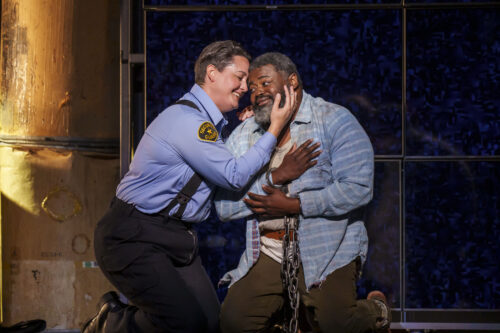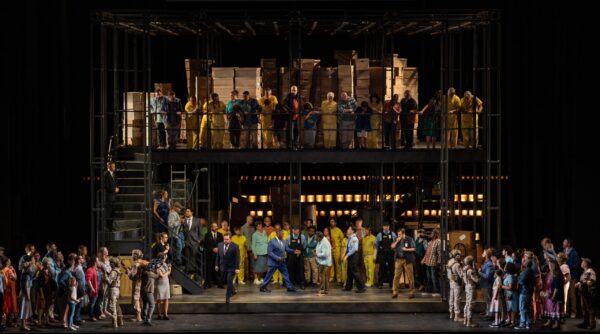 United Kingdom Beethoven, Fidelio: Soloists, Chorus and Orchestra of Lyric Opera of Chicago / Enrique Mazzola (conductor). Civic Opera House, Chicago, 29.9.2024. (JLZ)
United Kingdom Beethoven, Fidelio: Soloists, Chorus and Orchestra of Lyric Opera of Chicago / Enrique Mazzola (conductor). Civic Opera House, Chicago, 29.9.2024. (JLZ)

After some twenty years, it is a pleasure to see Fidelio back on the Lyric Opera stage in this exciting new production. Based on a libretto by Jean-Nicolas Bouilly which has inspired settings by Pierre Gaveaux (1898), Ferdinando Paër (1804) and Simon Mayr (1805), Fidelio endures in its depiction of profound love and the celebration of freedom. Those ideas found musical expression in Beethoven’s Leonore (1805), which he revised and gave its final form in 1814 as Fidelio.
The abuses during and after the French Revolution inspired the story of Leonore, who disguises herself as Fidelio to free her husband, Florestan, from his unjust incarceration. Productions often place the opera in the late-eighteenth and early-nineteenth centuries, but Matthew Ozawa’s staging offers a contemporary milieu set in the ‘distant past or near future’. The sets are clearly contemporary and offer a workable space for performing this iconic work effectively.
The overture was played well, but there were imbalances that carried into ensembles later in the performance. At times, the passages with faster notes were quick and loud, while the sustained pitches seemed to stop the flow and drive in the rest of the opera. However, the orchestra under Enrique Mazzola was outstanding in the more intricate textures and voicings in Act II, such as the sonorities that take us down to Florestan’s cell and allow his voice to be heard for the first time.
Elza van den Heever gave an impassioned performance as Leonore, and her dramatic touches added to the ways in which Leonore disguised herself as Fidelio. The irony of Marzelline becoming enamored with Fidelio is critical to the rescue, and Florestan needed to be reminded that his wife passed into the prison successfully to save him. Van den Heever set the tone at the opening of ‘Mir ist so wunderbar’, the quartet that reveals the thoughts of her character as well as those of Marzelline, Rocco and Jaquino. The distinct sounds and precise rhythms made the lyrics clear in this critical ensemble.
A similar approach was audible at the start of ‘Abscheulicher! Wo eilst du hin?’ and ‘Komm, Hoffnung, lass den letzten Stern’, but some of the sonorities in the orchestra masked her voice. A few passages were ambiguous, but van den Heever brought the resolve in this number to a dramatic musical conclusion. If some of the higher notes here had an edge, the duet in Act II, ‘O namenlose Freude!’, showed van den Heever’s upper range to advantage, especially in the florid passages that rang through as Leonore celebrated being reunited with Florestan.
Russell Thomas brought intensity to his role as Florestan. He was particularly effective in his phrasing in ‘Gott! Welch Dunkel hier!’ near the beginning of Act II, where the audience first perceives the fears of a doomed man. Thomas’s pacing brought out details in the score that suggest someone about to expire. Yet in the following number, Thomas shifted to a more sustained and legato style when he thought of an angel who resembles his wife helping him in his need. At this point the images of van den Heever projected on the screens near Florestan added to the effect as they foreshadowed the action to come. Thomas did not continue with the same intensity in the later numbers, although he matched van den Heever in ‘O namenlose Freude’.
Dimitry Ivashchenko was a superb Rocco. His flexible voice was reliably strong, as in ‘Hat man nicht auch Gold beineben’, where one could enjoy his solid pitch, phrasing and diction coming together. In the following trio, ‘Gut, Söhnchen, gut’, Ivashchenko brought his talents to the ensemble and worked nicely with van den Heever and Sydney Mancasola (Marzelline). Brian Mulligan gave voice to the villain Pizzaro, and his vow to murder Florestan (‘Ha, welch ein Augenblick’) had the audience on the edge of their seats. This revenge aria had the fire, passion and musicality it requires to sound convincing.
All the elements in this production came together, including Michael Black’s well-rehearsed Lyric Opera of Chicago Chorus. More than that, Ozawa’s staging of Fidelio suggests that these are contemporary issues – it is not a stretch to see that wrongful imprisonments and other injustices are as relevant today as they were when the story captured Beethoven’s imagination.
The two-level staging evoked a modern prison and worked well in keeping the drama moving with minimal scene changes. Lyric’s rotating stage was especially useful at the beginning of Act II when it showed various rooms and took the audience deep into the space where Florestan was left to die. That dank setting was transformed when the lighting changed for the final scene, and Florestan and Leonore walked into the light of a new day. It is rare to find an updating of an iconic opera like Fidelio that is so successful.
James L. Zychowicz
Featured Image: Lyric Opera of Chicago’s production of Fidelio.
Production:
Director – Matthew Ozawa
Sets & Projection – Alexander V. Nichols
Costumes – Jessica Jahn
Lighting – Yuki Nakase Link
Wigs & Makeup – John Metzner
Chorus director – Michael Black
Cast:
Leonore / Fidelio – Elza van den Heever
Florestan – Russell Thomas
Jaquino – Daniel Espinal
Marzelline – Sydney Mancasola
Rocco – Dimitry Ivashchenko
Don Pizarro – Brian Mulligan
First prisoner – Travon D. Walker
Second prisoner – Christopher Humbert, Jr.
Don Fernando – Alfred Walker
